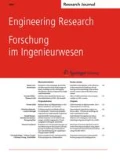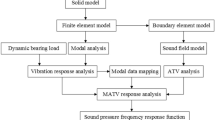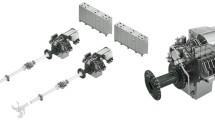Abstract
Reducing excessive vibration and undesired noise is one of the most important goals throughout the whole development phases of gearboxes. Among different development stages, different technical measurements are available to estimate the excitation behaviour of gear meshes.
However, the comparison of the result of these measurement types among the development stages may be inconsistent due to different dimensions. In order to ensure the best comparability as well as comprehensive interpretation of the vibration characteristics of gear meshes, an application force level was developed. This characteristic value allows noise behaviour evaluation by means of different measurement types. Moreover, the evaluation boundary of this characteristic value is customizable to encourage the flexibility for further specific evaluations.
In this article, the formulation of application force level is derived and its usage is shown. Although the application force level was intentionally developed for the gear design, it can also be applied to other kinds of application fields. The application force level is the result of the research project funded by the German research association for drive technology (FVA).
Zusammenfassung
Bei der Entwicklung von Getrieben ist ein günstiges Anregungsverhalten von Zahnrädern einer der wichtigsten Aspekte. In den Entwicklungsphasen können unterschiedliche Größen zur Beurteilung des Anregungsverhaltens verwendet werden, deren Vergleichbarkeit nicht immer gegeben ist aufgrund unterschiedlicher physikalischer Größen.
Um die durchgängige Auswertung des Anregungsverhalten in allen Entwicklungsphasen zu ermöglichen, wurde der Anwendungskraftpegel entwickelt. Mit Hilfe des Anwendungskraftpegels kann das Anregungsverhalten von Zahnrädern auf Basis unterschiedlicher Daten unter Berücksichtigung eines Auswertebereichs ausgewertet werden. Der Auswertebereich ist anwendungsspezifisch definierbar. Dadurch ist dieser Kennwert flexibel für verschiedenste Fälle einsetzbar.
Nachfolgend werden die Formulierung des Anwendungskraftpegels und Anwendungsbeispiele gezeigt. Obwohl der Kennwert ursprünglich zur Anwendung in Zahnradgetrieben entwickelt wurde, ist die Anwendung des Kennwerts in anderen Anwendungsbereichen möglich.
Der Anwendungskraftpegel ist Ergebnis von Forschungsvorhaben der Forschungsvereinigung Antriebstechnik e. V. (FVA).





Similar content being viewed by others
References
Albers A, Fischer J, Behrendt M, Lieske D (2015) Methods for measuring, analyzing and predicting the dynamic torque of an electric drive used in an automotive drivetrain. SAE Int J Alt Power 4(2):363–369. doi:10.4271/2015-01-2363
Bihr J, Heider M, Otto M, Stahl K, Kume T, Kato M (2014) Gear noise prediction in automotive transmissions. In: Proceedings of the international gear conference, pp 457–465
DIN EN ISO (Hrsg.): DIN EN ISO 1683: Acoustics – Preferred reference values for acoustic and vibratory levels. DIN EN ISO, 2013
Forschungsvereinigung Antriebstechnik e. V. (FVA) (2010) FVA-Heft 937: FVA-Forschungsvorhaben 338 V, DZP/DZPopt, DZP Version 5.0 und DZPopt Version 2.0. FVA, Frankfurt am Main (Abschlussbericht)
Geiser, H.: Grundlagen zur Beurteilung des Schwingungsverhaltens von Stirnrädern, TU München, Diss., 2002
Gerber, H.: Innere dynamische Zusatzkräfte bei Stirnradgetrieben, TU München, Diss., 1984
Gregory R, Harris S, Munro R (1964) Dynamic behaviour of spur gears. Proc Inst Mech Eng 178(Pt I No 8):207–226
Harris S (1958) Dynamic loads on the teeth of spur gears. Proc Inst Mech Eng 172:87–112
Heider M, Ingeli J (2011) FVA-Heft 983: FVA-Forschungsvorhaben 487 III, Neue Kennwerte zur rechnerischen Beurteilung des Anregungsverhaltens von Verzahnungen. Forschungsvereinigung Antriebstechnik e. V. (FVA), Frankfurt am Main (Abschlussbericht)
Heider M, Höhn B‑R, Stahl K, Otto M, Bihr J (2011) Assessment of the vibration excitation and optimization of cylindrical gears. In: Conference Proceedings of the ASME 2011 – 11th ASME International Power Transmission and Gearing, Washington DC. (DETC2011-47443)
Kohn B, Heider M, Otto M, Stahl K (2014) Meeting NVH requirements by low noise mesh design for a wide load range. In: In FISITA World Automotive Congress, Maastricht.
Kohn B, Otto M, Stahl K (2016) Noise reduction potential of waveform flank modifications. In: VDI Drivetrain for Vehicles 2016. VDI, Düsseldorf
Müller, R.: Schwingungs- und Geräuschanregung bei Stirnradgetrieben, TU München, Diss., 1991
Stahl K, Otto M, Zimmer M (2013) Striving for high load capacity and low noise excitation in gear design. In: Conference Proceeding – American Gear Manufacturers Association Fall Technical Meeting 2013, pp 138–151
Utakapan T (2015) FVA-Heft 1101: FVA-Forschungsvorhaben 487 IV, Neue Kennwerte zur rechnerischen Beurteilung des Anregungsverhaltens von Verzahnungen. Forschungsvereinigung Antriebstechnik e. V. (FVA), Frankfurt am Main (Abschlussbericht)
Utakapan T, Kohn B, Fromberger M, Heider M, Otto M, Höhn B‑R, Stahl K (2016) Measurement of gear noise behaviour for different microgeometries. In: Proceedings of the INTER-NOISE 2016 – 45th International Congress and Exposition on Noise Control Engineering: Towards a Quieter Future, pp 3964–3974
Author information
Authors and Affiliations
Corresponding author
Rights and permissions
About this article
Cite this article
Utakapan, T., Kohn, B., Fromberger, M. et al. Evaluation of gear noise behaviour with application force level. Forsch Ingenieurwes 81, 59–64 (2017). https://doi.org/10.1007/s10010-017-0228-y
Received:
Accepted:
Published:
Issue Date:
DOI: https://doi.org/10.1007/s10010-017-0228-y




